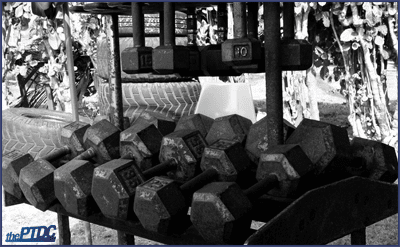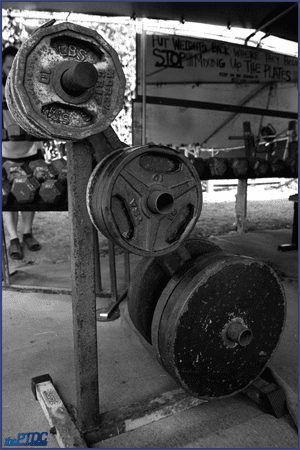Most lifters typically start out with a 3-5 split training program where each muscle group is trained once per week. For example, Monday is chest and triceps, Tuesday legs, Thursday back and biceps, and Friday is shoulders and abs.
Since these types of programs are regularly featured in training magazines, articles, and blogs and often advocated by professional bodybuilders, they're seen as the go-to for optimal muscle growth. However, as most coaches and people who've taken the time to read the actual research know, destroying each muscle group once a week makes little sense.
An Evolutionary Perspective
If we look at physical activity patterns from an evolutionary point of view, clearly the typical bodybuilding-type training of the 21st century is a novel behavior. As our prehistoric -- or even more contemporary -- ancestors didn't really train to maximize muscle growth and/or strength development, this doesn't really tell us that much in itself.
However, studying these indigenous activity patterns can help us understand what types of activities our genome "expects," and it's safe to say that doing 20 sets of isolated chest training to failure once a week isn't it.
It's also very clear that from an evolutionary perspective, humans can adapt to a fairly high training frequency. Hunter-gatherers, farmers, and other "primitive" human didn't train like powerlifters or bodybuilders, but they did lift heavy things, often doing the same movements every day.

What does the science say?
Studies looking at optimal training frequency
It's difficult to draw any firm conclusions from simply looking at studies investigating the effects of training frequency on hypertrophy, as they often have many limitations. If researchers investigate training frequency while keeping all other factors (e.g., volume, load, exercise selection) constant, we get an accurate picture of how frequency in itself affects muscular development, but it doesn't necessarily transfer very well into real life.
First, people who go from training each muscle group once a week to training each muscle group 2-3 times a week will generally train the compound lifts (e.g., squats, presses, bench press) more often, and typically progress better in these lifts.
In other words, they usually won't maintain the same exercise selection as before. Second, if you spread out the sets and repetitions over several days, you'll be able to lift heavier weights.
For example, a typical training frequency study will divide participants into two groups: one of which performs resistance training 1 day per week for 3 sets of each exercise at 70% of 1RM, while the other group train 3 days per week for 1 set of each exercise at 70% of 1RM.
In other words, the same volume in both groups. This offers a good picture of how frequency affects strength and muscle development, but it doesn't provide us with much info in terms of practical application.
In general, studies investigating training frequency while keeping volume constant show conflicting results. Some show slightly better gains from increased frequency, while others suggest that increased training frequency doesn't produce a significant effect. Overall, it's the results one would expect.
General recommendations
Luckily for us, some researchers have taken a comprehensive look at how strength training variables affect hypertrophy. In 2007, Mathias Wernbom and colleagues published a review on the influence of frequency, intensity, volume and mode of strength training on whole muscle cross-sectional area in humans:
- Load: 75-80% of 1RM
- Repetitions: 8-10 to muscular failure or near (range: 6-12)
- Sets: 1-3 per exercise. Progression from 1-2 to 3-6 sets in total per muscle group
- Velocity and duration per repetition: Moderate (Ecc= 1-2 sec. Con=1-2 sec.)
- Rest between sets: 60-180 seconds
- Frequency: 2-3 sessions per muscle group/week
Other comments: These recommendations are for novice to moderately trained individuals. Well-trained athletes may need increased variation in intensity and volume.
This is a lower volume per workout and higher frequency (per muscle group) than most bodybuilding programs. I'm using the term 'bodybuilding program' to refer to a 3-6 day split where each muscle group is trained once per week (typically high volume, 15-30 sets per muscle group). I know this is a generalization as many bodybuilding programs don't look like this, but it's a common term people understand.
If we stop to think about it, the fact that 2-3 sessions per muscle group/week is superior to 1 doesn't really come as a surprise, as an increased frequency will promote a more frequent stimulus and typically allow you to progress faster in the compound lifts. However, it's important to note that these recommendations refer to heavy training to failure or near failure.
Besides the guidelines above for conventional hypertrophy training, the review shows that multiple sessions per muscle group/week is beneficial for other types of resistance training aimed at increasing whole muscle cross-sectional area (e.g., moderate load slow-speed training, eccentric overload training).
In terms of strength development, it's known that training every compound lift once per week is inferior to multiple sessions, so I won't delve into the research on that. There are some very effective powerlifting programs where every lift is only trained once per week, but these are the exceptions rather than the rule.
In my experience, 30-60 reps for each muscle group 2-3 times per week is optimal for the majority of people. However, while I agree that the load should be in the 75-80% of 1RM range most of the time, I've found that it's generally beneficial to employ both high rep and low rep training, e.g., 4-8 reps in the major lifts and 8-12 in other exercises, which gives a range of 65-90% of 1RM.
I moved away from the typical bodybuilding-type program many years ago. Not to say that I don't see the benefits of this type of training, but clearly for most people, training every muscle group 2-3 times per week (or at least 2 times in 10 days) is superior to once a week. Sure, if you're a competitive bodybuilder who's found that training every muscle group once a week is what works best for you, certainly continue doing that. However, for the average lifter, that is rarely the optimal way.
Beginners
For a novice individual who wants to gain muscle and strength, simply doing the compound movements, such as the squat, deadlift, press, bench-press, and chin-up is more than enough. So, even if the goal is to maximize hypertrophy, a starting strength-type program is usually the way to go for beginners. This means that each compound exercise is trained heavy 2-3 times per week (often just once for deadlifts).
Once the trainee masters the fundamental technical aspects, the focus should be on progressive overload. In other words, beginners should be adding weight to the bar every workout, meaning that the progress is pretty much linear for the first couple of weeks (weight added, not percentages). Generally, for this untrained population, periodization and advanced programming aren't necessary.
If I think back at the beginning of my own lifting career, the primary thing I'd change is that I'd have completely stayed away from the high volume training and instead just focused on the compound lifts. In other words, I would've built a fundamental base before I started mixing things up.

Intermediate-experienced lifters
For intermediate lifters who want to gain muscle and strength, the focus should still be on progressive overload in a set of compound lifts. However, these trained individuals typically benefit from including some additional "pump" work, arm training, etc.
From a practical point of view, this could mean that you do a 2 day split, training 4 times per week. Begin with a heavy compound lift for each muscle group before you move on to 1-2 additional "random" exercises.
While most beginners can stick with the same weight for all the sets on an exercise, I've found that this isn't always optimal for more experienced trainees.
Let's say that you add 200 lbs to the bar and do a set to failure. To get the same amount of reps on the next set (with the same weight) the rest periods would have to be upwards of 4 to 6 min. While waiting this long could be an option for some lifters, rest periods of about 2-3 min are preferred by the majority.
In other words, unless you're a competitive powerlifter who's training for a special performance goal, you don't need to sit around forever to regain your strength. I see no problem with taking long breaks between each set when you're doing low-rep heavy lifting, but the fact is that most people don't want to spend 2 hours in the gym -- especially when there isn't really an advantage to these long rest periods (for most lifters).
So what if you want to take each set to failure with the same number of reps, without having to wait forever to recuperate? One strategy is to use Reverse Pyramid Training.
For example, let's say you're doing 4 sets of squats, 4-6 reps on each set. Begin by doing 3-4 light warm-up sets, and then add the planned amount of weight for that day (e.g., 250 lbs). Do 4-6 reps on 250, take a 2 minute break, strip off some of the weight and do 4-6 reps, wait 2 minutes, strip off more weight and do 4-6 reps, and so on.
If you managed to get 6 reps on each set, increase the load next workout. If you only managed to get 4 or 5 reps on one or more of the sets, stick with the same weight until you get 6. When you're getting used to this type of training you'll start to understand how much weight you need to take off each time to meet your rep target.
From a practical standpoint, 30-60 reps per muscle group could mean the following on a chest workout: bench press 4x5, dips 2x8, and incline dumbbell press 1x10.
One instance where intermediate-experienced lifters often don't need anything besides the most basic lifts is after an unplanned break from training. Following an unplanned break (e.g., illness, lack of motivation) simply doing a full-body workout for 1-3 weeks is a great way to regain strength and get back in the groove.
The law of accommodation
Essentially, while the whole muscle confusion thing is largely nonsense (you shouldn't' be doing different exercises, rep-ranges, etc., every workout in an attempt to "confuse" the muscle), there is some truth to the idea that you shouldn't be doing the exact same program for prolonged periods of time.
In other words, you need to occasionally mix things up, change your rep ranges (e.g., if you've been doing low rep for a long time, try doing lighter weight for higher reps for a period), do a bodybuilding-type training program for a while, etc. However, it's very important that there's a system to it.
Don't just mess around with completely random workouts, but stay on top of your progress. This all comes back to the law of accommodation, a "biological law that states that a decrease in adaptation will occur to a repeated stimulus over an extended period of time."
One of the primary reasons deloading, periodization, etc., is often so effective is because of this accommodation that's occurred over time. Even though you aren't necessarily "overtrained" or in desperate need of a break, taking a step back and/or mixing things up will typically help your progress.
For beginners workout programs, this law of accommodation isn't that relevant, as they can keep progressing in the basic lifts for several months. However, for more experienced trainees, it's definitely something to keep in the back of the mind. I've made the personal trainer mistake of sticking to the same exercises, with the same amount of sets and reps, for prolonged periods of time before, and if there's one thing I've learned it is that this type of training often leads to stagnation. So, in some regards, muscle "confusion" does hold true.
Bottom line, why should you train every major muscle group more than once a week?
- Higher frequency allows you train the compound lifts more often. Generally, you also progress in these lifts faster this way.
- Compared to destroying each muscle group once a week, 30-60 reps for each muscle group 2-3 times per week is more in line with the physical activity patterns that shaped our genome.
- Higher frequency leads to a more frequent stimulus.
The scientific literature suggests that for the vast majority of people interested in gaining muscle and/or strength, training every major muscle group (or compound exercise) more than once a week is optimal.









